Finding the right conference table involves considering shape, size, material, and style. This buyer’s guide helps you choose the best table for your space, budget, and team size, covering various options and features.
What Are Conference Tables and Why Are They Important?
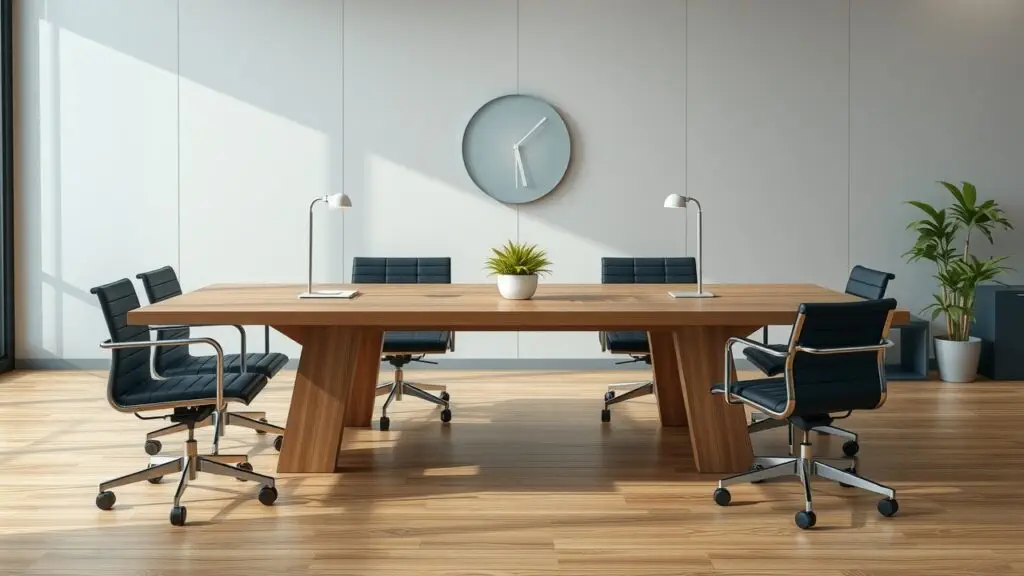
Conference tables are key pieces of office furniture meant for meetings and discussions. They help create a space that encourages communication and teamwork. The right conference table can boost collaboration by offering enough room for everyone while also improving the look of a meeting area.
Picking the right style and size of a conference table matters. It affects how productive meetings can be. A well-made conference table not only works well but also shows off the company’s brand and values.
Benefits of Conference Tables
- Better Collaboration: A spacious table lets team members share ideas more easily.
- Professional Look: Quality materials enhance your company’s image.
- Flexibility: Different shapes work for different types of meetings, from formal talks to casual brainstorming.
Knowing these benefits helps businesses choose the best conference tables for their needs.
Common Uses for Conference Tables
Conference tables have many uses in different settings. In places like boardrooms or executive offices, they’re often used for important meetings where big decisions happen. Training rooms use these tables for workshops that need group involvement.
In schools or creative settings, smaller round or square tables may be better to encourage interaction. Understanding how various industries use these versatile tables helps in making smart choices that fit specific needs.
Overall usage includes:
- Boardrooms: Larger rectangular tables are best for formal presentations.
- Training Rooms: Flexible setups can change based on group size.
- Brainstorming Sessions: Smaller round tables help with open discussions.
- Interviews: Compact tables are great for one-on-one conversations.
By knowing these common uses—like classic wooden designs versus modern glass styles—organizations can pick what works best for them.
Types of Conference Table Shapes Explained
Rectangular Conference Tables – Versatile & Practical
Rectangular conference tables are common in many offices. They work great for large teams or formal settings. The long shape means more seats, perfect for boardroom meetings or presentations. This classic design fits various industries, from corporate offices to schools.
But there’s a downside. In smaller groups, these tables can feel a bit cold or distant. If the room is tight, the table might take up too much space and make it hard for people sitting far apart to talk.
Key Features:
- Pros: High seating capacity; adaptable design across different sectors.
- Cons: Can feel impersonal in small settings; space may be wasted in small rooms.
Round Conference Tables – Promoting Equality & Collaboration
Round conference tables create a friendly atmosphere where everyone feels included. Without corners, they encourage open discussions and help everyone engage. These tables are great for brainstorming sessions or small team meet-ups where teamwork is key.
They also fit well in smaller spaces, making them perfect for informal chats and collaborative workspaces that focus on teamwork.
Ideal Use Cases:
- Brainstorming sessions
- Small team gatherings
- Casual discussions
Oval Conference Tables – Balanced Design Choice
Oval conference tables blend the best of both rectangular and round shapes. They offer enough space while looking softer and friendlier thanks to their rounded edges. This makes them suitable for medium-sized teams who want to encourage interaction but still need comfort.
The oval shape allows inclusivity like round tables but offers more surface area for documents or tech needed during meetings, making them popular in executive conference rooms.
Square Meeting Tables – Compact Solutions for Smaller Spaces
Square meeting tables are perfect for tight spaces or quick chats between people. Their equal sides make them a good fit for small rooms often found in modern offices.
These tables work well for interviews or breakouts during events where discussions are brief and don’t require a lot of setup. Just remember, square tables might limit how many people can sit comfortably based on the room size.
Pros & Cons:
- Pros: Space-efficient design fits well in small areas.
- Cons: Limited seating capacity may restrict larger group interactions; practical issues arise with room size when choosing this option.
Other Conference Table Shapes and Styles
Unique Conference Table Shapes
Choosing the right conference table shape is important. It can really change how your meeting space works. Here are some unique types of conference tables to look at:
U-shaped Conference Tables
U-shaped conference tables create a friendly space for everyone. This shape makes it easy for people to talk and see each other. It’s great for presentations or training sessions because it encourages teamwork and participation. Everyone gets a good view of any visual aids, which helps with discussions.
Boat-shaped Conference Tables
Boat-shaped conference tables are made with sloping edges. This design helps everyone in formal meetings see each other clearly. It’s perfect for executive meetings where communication is key. The professional look fits well in boardrooms, making them a favorite choice for serious discussions.
Crescent Conference Tables
Crescent-shaped tables help boost teamwork. Participants can sit facing each other, making it easier to share ideas. Plus, there’s a central space that can hold materials or tech needed during meetings. This shape works well when collaboration and brainstorming are important.
Modular Conference Tables
Modular conference tables give you lots of options for different meeting setups. You can move these tables around easily to fit the needs of workshops or group discussions. Their flexibility allows teams to create the best layout for their gathering, making them ideal for busy work environments.
Knowing these unique shapes can help you find the best conference table for your needs and improve how effective your meetings are.
Choosing the Right Material for Your Conference Table
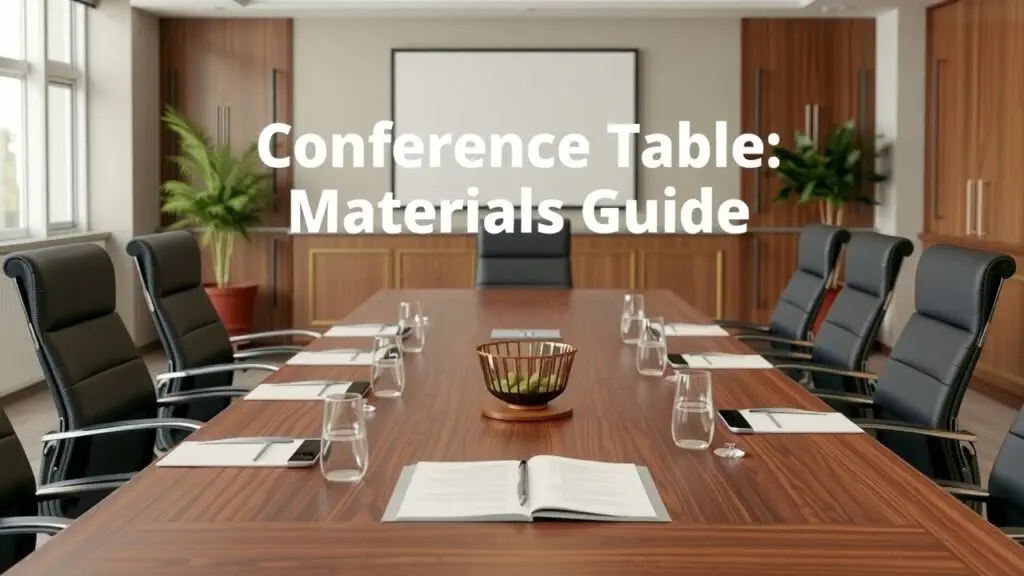
Picking the right material for your conference table is important. It can change how your space looks and how well it works for meetings. Different materials come with their own perks and downsides that can help you decide based on your style, budget, and needs.
Wood
Wooden conference tables are a favorite for many because they look classic and last a long time. Popular types of wood include cherry, mahogany, and oak. Cherry has a warm color that gets richer over time. Mahogany looks fancy and rich, while oak is tough with clear grain patterns. The texture of wood can really add to the feel of your meeting room.
Wood tables might be pricier than other options, but they often last longer. Taking good care of them helps them stay nice for years.
Laminate
Laminate conference tables are a budget-friendly choice. They have a composite base with a thin layer that looks like wood or other finishes.
Pros:
- Affordable
- Easy to clean
- Scratch-resistant
Cons:
- Not as strong as solid wood
- May not look as good
When choosing laminate, think about the price compared to how long it will last. Cheaper laminates might wear out faster if used a lot.
Metal
Metal conference tables are becoming more popular in modern offices because they look sleek and are very strong. Common metals include steel and aluminum.
Steel is super strong but might need some care to prevent rust if it gets wet. Aluminum is lighter but still durable, making it easy to move when needed.
Benefits of metal furniture include:
- Long-lasting durability
- Little maintenance needed
- Stylish appearance
These traits make metal a smart choice for busy workspaces where flexibility matters.
Glass
Glass-topped conference tables bring a modern touch and can make spaces feel more open. However, they need some careful thought about safety and upkeep.
Pros:
- Contemporary look
- Reflects light nicely
Cons:
- Shows fingerprints easily
- Can break if not handled properly
For meeting areas aiming for style without losing openness, glass is great when combined with sturdy bases like wood or metal.
Stone
Stone materials such as granite or marble add a touch of luxury to any boardroom but usually come at higher costs compared to other options. They are incredibly strong but need regular sealing to prevent stains—especially important in areas that see lots of use.
Adding stone elements creates a significant presence while ensuring quality over time when well cared for.
Mixed Materials
Custom designs using mixed materials let you mix aesthetics with function in your workspace. For example, combining wood tops with metal bases creates eye-catching contrasts while improving stability during meetings that require tech setups with cable management hidden beneath the tabletop.
Optimizing Size and Seating for Your Needs
Choosing the right conference table is key. It affects how well your meetings go. Consider table size, seating capacity, and space planning to make a good meeting area. This helps create an environment where people can share ideas easily.
Determining Table Size
When picking a conference table, knowing about conference table sizes is a must. The size of the table should fit your team and the room. For example, rectangular conference tables usually have more space for bigger groups than round or oval tables.
Here are some important things to think about:
- Team Size: Count how many folks will be at meetings. A good rule is to give each person about 24 inches of space.
- Room Dimensions: Measure your meeting room. Make sure there’s enough space for the table without it feeling cramped.
- Desired Spacing: Leave enough room around the table for everyone to move comfortably.
Seating Capacity
Knowing the seating capacity helps when choosing between large and small conference tables. Different shapes can change how many people fit comfortably:
| Table Shape | Typical Seating Capacity |
|---|---|
| Rectangular | 6 – 12 |
| Round | 4 – 10 |
| Oval | 8 – 14 |
| Square | Up to 8 |
These numbers can change based on the table design. Think about adding extra chairs for unexpected guests or changing setups as needed.
Space Planning
Good office layout helps boost interaction during meetings. Here are some important tips for space planning:
- Walkways Around Tables: Make sure there’s enough room around the table so people can get in and out easily.
- Coordination with Other Furniture: Check how other furniture fits into your meeting room layout so it doesn’t block movement or conversations.
By focusing on these factors—table size, seating capacity, and space planning—you can create a useful meeting spot that fits your team’s needs. This will help improve teamwork in every meeting!
Enhancing Functionality and Aesthetics
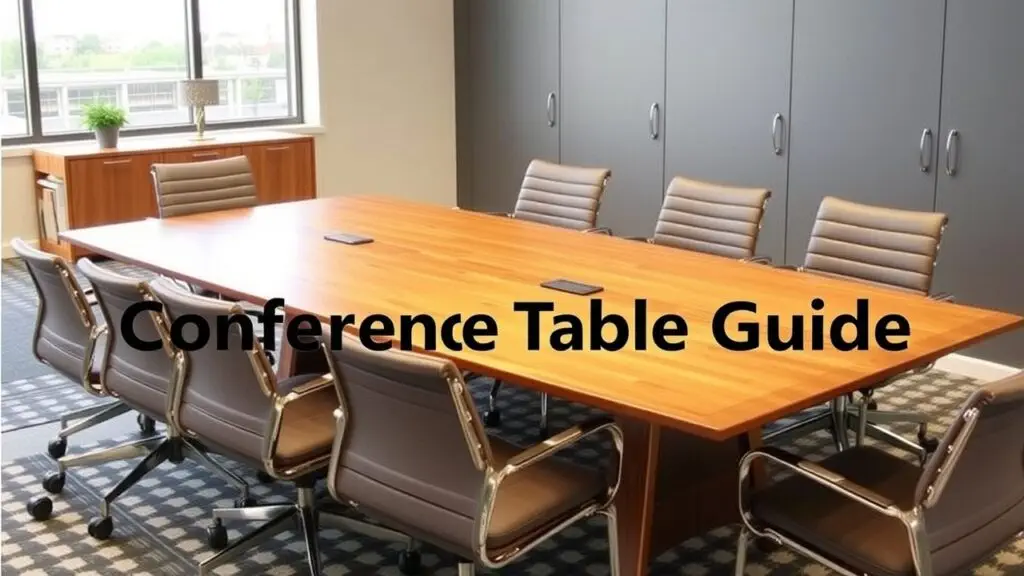
Cable Management Solutions
Keeping cables organized in a professional space is key for a clean look and safety. Messy cords can distract people during meetings and cause accidents. Good cable management solutions help maintain a neat workspace while making tech easily reachable.
There are many options for managing cables in conference tables:
- Integrated power outlets let you plug in devices without messy cords.
- Grommets provide tidy spots for cables to enter, hiding them from view.
- Cable trays under the table can keep extra wires out of sight, helping create a more focused environment.
Height Adjustability
Height-adjustable conference tables offer real comfort by fitting different meeting styles and user needs. You can change their height so that people can sit or stand comfortably during discussions.
Height adjustability is more than just comfy; it boosts engagement. When people can move around, they’re more involved in discussions. This flexibility not only meets personal preferences but also helps teams work better together, especially during group activities.
Modern vs. Traditional Styles
Choosing between modern and traditional conference tables is important for matching your office’s design vibe.
Modern conference tables usually have:
- Sleek lines
- Simple designs
- Materials like glass or metal that fit today’s trends
Color choices often lean toward neutral shades with pops of color for interest.
On the flip side, traditional conference tables show off:
- Rich wood finishes with classic details
- Familiar shapes like rectangular or oval
- Warm colors that build trust in corporate settings
| Style | Key Features | Material Choices |
|---|---|---|
| Modern | Sleek lines, minimalism | Glass, metal |
| Traditional | Rich wood finishes, ornate details | Solid wood |
Customization Options
Customization matters when creating unique conference tables that show off your company’s identity. There are plenty of ways to make your table special—like adding logos or custom finishes that match your brand colors.
These personalized designs boost the look of the room and give employees a sense of pride by showing off what the company stands for in shared spaces like meeting rooms.
AV Integration Features
In today’s world, it’s crucial to integrate technology into meeting spaces seamlessly. Advanced audiovisual (AV) integration features help meetings run smoothly.
Examples include:
- Built-in data ports for easy laptop connections
- Multimedia connections for video calls, helping communication flow regardless of where team members are located
Having these features enhances efficiency across different work setups and makes presentations easier and more engaging.
Maximizing Your Investment
When you buy conference tables, think beyond just the cost. You also need to know how to take care of them. Good maintenance keeps your furniture looking great and working well for a long time.
Ergonomics for Optimal Comfort and Productivity
Ergonomic conference tables help you feel comfortable. They support good posture and reduce tiredness during long meetings. When choosing a table, pay attention to seating arrangements. Make sure chair heights fit well with the table’s height so everyone can sit comfortably. Leave enough space between chairs for people to move around easily and work together.
Room Layout and Furniture Arrangement
The setup of your meeting room really matters. A smart conference room layout boosts communication among team members. It creates a welcoming spot for discussions too. Think about how big your room is when picking furniture. In larger rooms, long rectangular tables work well for group talks. Smaller spaces might do better with round or oval tables that encourage chatting without crowding.
Maintenance and Cleaning
Taking care of your office furniture is key, especially for conference tables that get a lot of use. Here are some best practices:
- Cleaning: Choose cleaning products based on what your table is made of—wood, glass, or laminate—to keep it safe.
- Inspection: Regularly look for scratches or dents; fixing them early helps avoid bigger problems later.
- Protection: Use coasters or placemats during meetings to shield surfaces from heat and moisture.
By following these tips on ergonomics, layout planning, and maintenance practices focused on conference tables, you can boost comfort and productivity in your workspace.
FAQs About Conference Tables
What are the most popular types of conference tables?
Popular types include rectangular, round, oval, and U-shaped conference tables. Each shape serves different meeting styles and group sizes.
How do I choose the right size for a conference table?
Consider your room size and the number of attendees. Ensure there’s enough space for movement around the table. Aim for 24 inches of space per person.
What materials are used for conference tables?
Conference tables come in wood, laminate, metal, glass, and stone. Each material offers unique benefits in style and durability.
What features should I look for in a conference table?
Look for features like cable management solutions, height adjustability, and built-in power outlets. These enhance usability during meetings.
Where can I find high-quality conference tables?
You can find quality options at online retailers and specialized furniture stores. Compare different brands to ensure you choose the best fit.
Conference Table Features to Consider
- Modular Conference Tables: Flexible designs allow easy reconfiguration.
- Height Adjustable Conference Tables: Support varied meeting styles.
- Mobile Conference Tables: Easy to move for different setups.
- Conference Table with Power Outlets: Keeps devices charged during meetings.
- Trapezoid Conference Tables: Unique shape allows creative arrangements.
- Removable Conference Table Sections: Adaptable for changing needs.
Buying Guide for Conference Tables
- Budget Conference Tables: Affordable options without compromising quality.
- High-End Conference Tables: Premium designs with luxurious materials.
- Custom Conference Tables: Tailor-made solutions to fit specific requirements.
- Conference Table Seating Capacity: Choose based on group size and arrangement.
- Sustainable Conference Tables: Eco-friendly materials support green initiatives.
- Conference Table Maintenance Tips: Regular cleaning extends lifespan.
Popular Styles of Conference Tables
- Modern Conference Tables: Sleek designs that suit contemporary offices.
- Traditional Conference Tables: Classic styles add warmth to any room.
- Executive Conference Tables: High-quality finishes convey professionalism.
Options for Unique Meeting Spaces
- Crescent Shaped Conference Tables: Promote interaction among participants.
- Folding Conference Tables: Space-saving options ideal for multifunctional rooms.
- Collaborative Workspace Furniture: Enhance teamwork with suitable setups.
These features and considerations can help you find the perfect conference table tailored to your business needs.
Related Topics
- Types of Conference Table Shapes
- Types of Conference Table Materials
- Types of Conference Table Styles
- Types of Cable Management Solutions for Conference Tables
- Types of Conference Table Features
- Types of Conference Room Layouts
- Types of Conference Table Brands
- Types of Conference Table Sizes

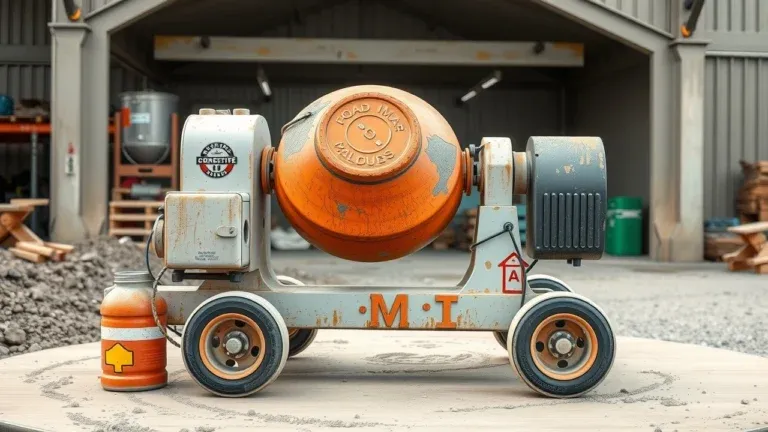
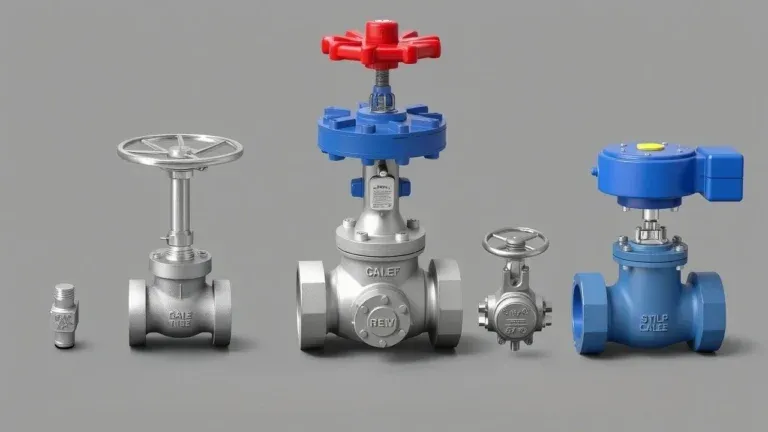
Types of Conference Tables: A Buyer’s Guide to Choosing the Best Table for Your Needs